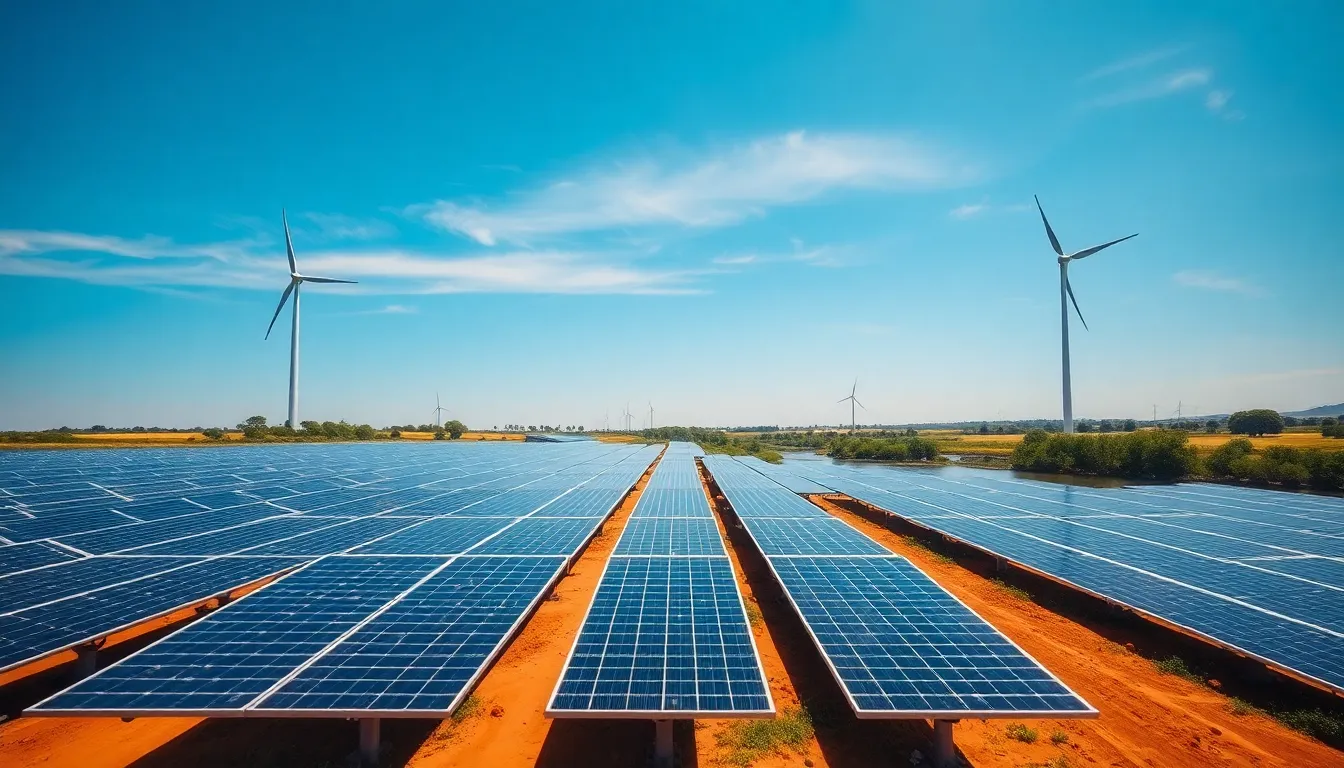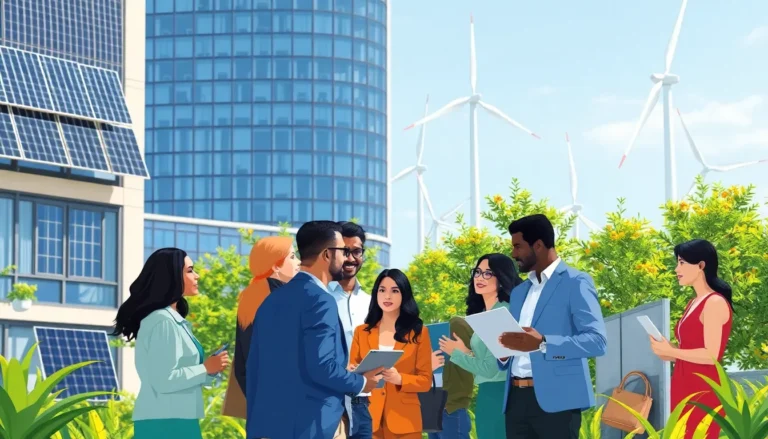In a world where the sun shines brighter than your neighbor’s new car, renewable innovations are taking center stage. Imagine harnessing the power of wind, sun, and even the occasional enthusiastic wave to fuel our lives. It’s not just a dream; it’s happening right now, and it’s cooler than a polar bear in sunglasses.
Table of Contents
ToggleOverview of Renewable Innovations
Renewable innovations encompass a variety of technologies that transform natural resources into sustainable energy. Solar power technology, including photovoltaic cells and concentrated solar power systems, plays a critical role in global energy production. Wind energy innovations focus on offshore and onshore wind farms, leveraging wind turbine advancements to increase efficiency.
Bioenergy, generated from organic materials, includes biofuels and biomass, contributing to energy sustainability. Hydrogen fuel cells offer a clean energy alternative with significant potential for transport applications. Geothermal energy systems harness heat from the Earth, providing consistent energy regardless of weather conditions.
Wave and tidal energy technologies exploit ocean currents and tides, presenting another innovative solution for energy generation. Energy storage innovations, such as lithium-ion batteries and pumped hydro storage, enhance the reliability of renewable energy sources. Smart grid technologies integrate various energy systems, optimize distribution, and improve energy management.
Government policies and incentives support the development of these technologies, encouraging investment in renewable energy sectors. Collaborations between private companies and research institutions foster innovation, leading to breakthroughs in energy efficiency and application. The urgency of addressing climate change accelerates the adoption of renewable innovations, making them a key element of future energy strategies.
These advancements in renewable energy are reshaping the energy landscape, ensuring that sustainable solutions remain at the forefront of global energy discussions.
Types of Renewable Innovations

Various renewable innovations are transforming the energy landscape. Key types include advancements in solar energy, wind energy, biomass, and hydropower.
Solar Energy Advancements
Photovoltaic cells convert sunlight into electricity efficiently. Concentrated solar power systems utilize mirrors or lenses to focus sunlight, producing high-temperature heat for energy generation. Innovations like solar skins integrate seamlessly into building designs, enhancing aesthetics while generating energy. Solar tracking systems increase efficiency by adjusting panels to follow the sun’s movement. These advancements collectively make solar energy a critical player in meeting global energy demands.
Wind Energy Technologies
Offshore wind farms harness stronger and more consistent winds compared to onshore installations. Turbines designed for low-wind conditions expand the viability of wind energy in diverse locations. Vertical-axis turbines represent a growing innovation, allowing for greater efficiency and aesthetic flexibility. Drones and AI are deployed for maintenance and monitoring, enhancing operational efficiency. These technologies showcase wind energy’s potential for sustainable electricity generation.
Biomass Innovations
Biomass transformation processes convert organic materials into biofuels, providing renewable energy sources. Advanced anaerobic digestion techniques yield biogas from organic waste, promoting waste reduction and resource recovery. Research on algae as a feedstock for biofuel production demonstrates significant potential due to its rapid growth and high yield. Innovations in pelletization enhance the efficiency of biomass combustion systems. These developments position biomass as a vital contributor to renewable energy portfolios.
Hydropower Developments
Hydropower technologies have evolved with small-scale and micro-hydropower systems, making energy generation accessible in remote areas. Pumped storage hydropower provides a reliable method for energy storage and grid stability. Innovations in fish-friendly turbine designs minimize ecological impacts, supporting sustainable practices. Real-time monitoring systems optimize water flow management, improving efficiency. These advances illustrate hydropower’s continuing relevance in the renewable energy sector.
Impact of Renewable Innovations
Renewable innovations significantly transform environmental and economic landscapes. These advancements drive sustainable practices and promote financial growth.
Environmental Benefits
Clean energy sources reduce greenhouse gas emissions. Solar panels and wind turbines generate electricity without releasing harmful pollutants. Enhanced energy efficiency challenges traditional fossil fuels. Biodiversity gains from renewable projects also increase as environmental impacts lessen. Innovative energy solutions contribute to healthier ecosystems while mitigating climate change factors. Communities benefit from cleaner air and water quality, leading to improved public health. Renewable innovations foster resilience against natural disasters, preparing regions for climate impacts.
Economic Implications
Job creation emerges from the renewable sector’s rapid growth. The International Renewable Energy Agency reported over 11 million jobs in renewables by 2018, indicating robust employment opportunities. Investments in clean technologies stimulate local economies, fostering innovation and technological advancements. Energy independence grows as regions reduce reliance on imported fossil fuels, stabilizing energy prices. Cost reductions in solar and wind technologies enhance competitiveness, attracting investments. Governments benefit from decreased healthcare costs due to improved public health and cleaner environments. Overall, renewable innovations promote sustainable economic development while addressing pressing energy challenges.
Challenges Facing Renewable Innovations
Innovations in renewable energy face several significant challenges that hinder their widespread adoption.
Technological Barriers
Technological challenges impede the efficiency and scalability of renewable innovations. As developments continue, issues such as storage capacity and grid integration require attention. Energy storage technologies, although evolving, don’t yet meet the demand for long-term solutions. Materials used in solar cells and wind turbines often have durability concerns that affect lifespan and performance. Moreover, manufacturing processes for these technologies can be resource-intensive and costly. Advances in battery technology need further exploration to improve usability and reduce costs. Innovative approaches to solar panel recycling also remain insufficient, leading to waste management concerns. Overcoming these barriers will foster greater reliance on renewable sources.
Policy and Regulation Issues
Policy and regulatory challenges present formidable obstacles for renewable innovations. Inconsistent government policies can create uncertainty for investors and developers. Without clear regulations, markets struggle to adapt to new energy technologies, restricting competition. Incentives for renewable energy sources vary widely across regions, impacting implementation timelines. Additionally, interconnection standards and permitting processes often delay project initiation. Local, state, and federal collaboration is essential to establishing stable frameworks. Adopting streamlined regulations will support innovation and growth in the renewable sector. Addressing these policy issues remains crucial for long-term sustainable energy goals.
Future Trends in Renewable Innovations
Emerging technologies continue to drive advancements in renewable innovations. Researchers focus on enhancing energy efficiency through next-gen photovoltaic cells that convert sunlight into electricity at unprecedented rates. Innovations in solar skins make these systems more visually appealing while improving energy capture.
Wind energy also sees significant improvements. Offshore wind farms expand in number and efficiency, using larger turbines that harness more power. Vertical-axis turbines gain attention for their ability to function in varied wind conditions, demonstrating versatility.
Biomass energy production evolves through advanced anaerobic digestion techniques. These innovations convert organic waste into clean energy by optimizing the digestion process, increasing yield while reducing emissions. Algae feedstock development positions algae as a potent source for biofuel.
Hydropower advancements reflect a growing emphasis on sustainability. Small-scale systems emerge as alternatives, allowing communities to harness local water resources effectively. Fish-friendly turbine designs minimize ecological disruption, enhancing hydropower’s compatibility with environmental conservation.
Energy storage solutions are critical in addressing the intermittency of renewable sources. New lithium-sulfur batteries offer higher energy densities, promoting longer-lasting storage capabilities. Research into next-generation pumped hydro storage systems shows promise in improving overall energy management.
Smart grid technologies reshape energy distribution and usage. Integrated systems optimize resource management, allowing for real-time adjustments based on demand fluctuations. The transformation plays a crucial role in enhancing grid stability and promoting renewable energy adoption.
Government support remains vital in this transformation. Policy incentives and research funding accelerate innovation, ensuring that renewable technologies remain competitive and secure. Strong collaborations between private companies and research institutions foster an environment for groundbreaking solutions, essential for a sustainable energy future.
The landscape of renewable innovations is rapidly evolving and holds immense promise for the future. As technology advances and efficiency improves, the potential to harness clean energy sources becomes more viable. The integration of smart grid systems and energy storage solutions enhances reliability and accessibility, paving the way for a sustainable energy transition.
With government support and private sector collaboration, the renewable energy sector is poised for significant growth. The focus on reducing emissions and fostering economic development will drive further innovations. As these technologies continue to develop, they’ll play a crucial role in addressing climate change and ensuring a healthier planet for future generations. Embracing renewable innovations is not just a necessity but an opportunity for a brighter and more sustainable future.










